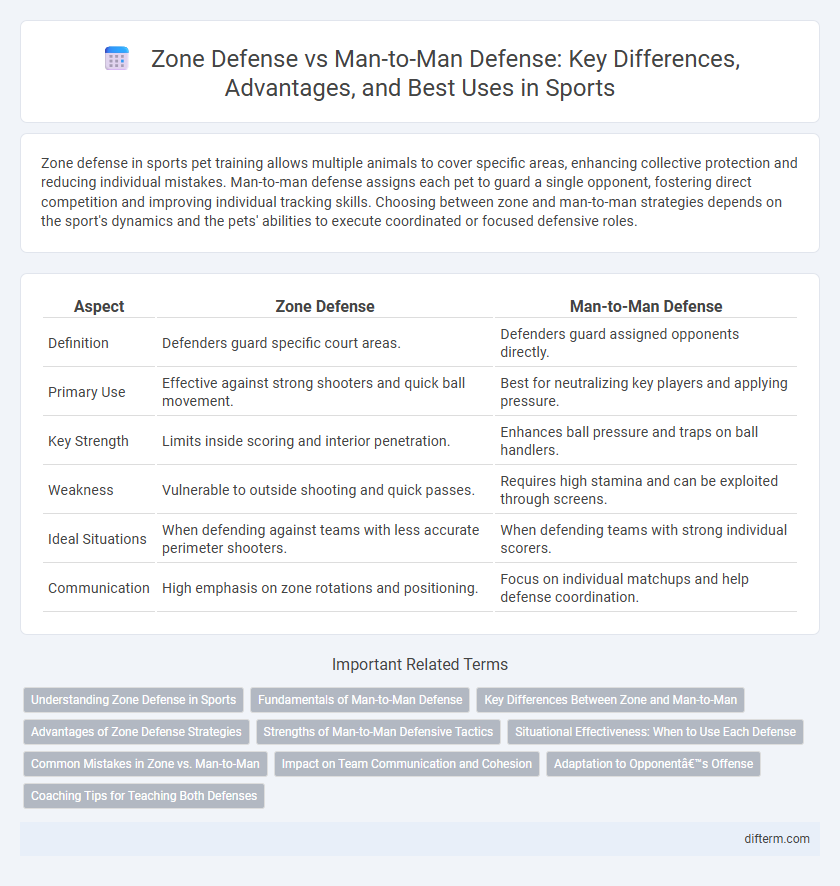Zone defense in sports pet training allows multiple animals to cover specific areas, enhancing collective protection and reducing individual mistakes. Man-to-man defense assigns each pet to guard a single opponent, fostering direct competition and improving individual tracking skills. Choosing between zone and man-to-man strategies depends on the sport's dynamics and the pets' abilities to execute coordinated or focused defensive roles.
Table of Comparison
| Aspect | Zone Defense | Man-to-Man Defense |
|---|---|---|
| Definition | Defenders guard specific court areas. | Defenders guard assigned opponents directly. |
| Primary Use | Effective against strong shooters and quick ball movement. | Best for neutralizing key players and applying pressure. |
| Key Strength | Limits inside scoring and interior penetration. | Enhances ball pressure and traps on ball handlers. |
| Weakness | Vulnerable to outside shooting and quick passes. | Requires high stamina and can be exploited through screens. |
| Ideal Situations | When defending against teams with less accurate perimeter shooters. | When defending teams with strong individual scorers. |
| Communication | High emphasis on zone rotations and positioning. | Focus on individual matchups and help defense coordination. |
Understanding Zone Defense in Sports
Zone defense in sports involves players covering specific areas on the court or field rather than marking individual opponents. This strategy enhances team coordination by focusing on spatial control, making it difficult for the opposing team to find open lanes or scoring opportunities. Effective zone defense requires strong communication and awareness to shift and cover gaps as the offense moves.
Fundamentals of Man-to-Man Defense
Man-to-man defense fundamentals emphasize individual responsibility, requiring each player to closely guard a specific opponent to limit scoring opportunities and force turnovers. Key techniques include maintaining proper defensive stance, denying passing lanes, and effective footwork to stay between the offensive player and the basket. Mastery of communication, anticipation, and physical conditioning enhances defensive pressure and adaptability within this strategy.
Key Differences Between Zone and Man-to-Man
Zone defense assigns players to guard specific areas on the court, enhancing coverage and limiting penetration by forcing outside shots. Man-to-man defense requires each player to closely follow and challenge a specific opponent, which increases pressure and can disrupt individual offensive skills. While zone defense conserves energy and supports team coordination, man-to-man defense emphasizes individual accountability and aggressive contesting.
Advantages of Zone Defense Strategies
Zone defense strategies provide teams with enhanced spatial control by covering specific court areas rather than individual opponents, reducing the risk of mismatches. This approach improves defensive communication and helps protect the paint, effectively limiting high-percentage shots near the basket. Teams using zone defense can also conserve player energy by minimizing constant man-to-man tracking, leading to increased stamina during critical game moments.
Strengths of Man-to-Man Defensive Tactics
Man-to-man defense excels in applying intense pressure on individual opponents, allowing defenders to closely contest shots and disrupt passing lanes. Its strength lies in fostering accountability, as each player is responsible for guarding a specific opponent, enhancing overall team cohesion and communication. This defensive tactic also adapts effectively to offensive schemes by enabling quick switches and double-teams, increasing the potential for turnovers and defensive stops.
Situational Effectiveness: When to Use Each Defense
Zone defense maximizes effectiveness against teams with strong individual scorers by clogging passing lanes and forcing outside shots. Man-to-man defense excels in pressuring ball handlers and exploiting mismatches, ideal against teams with balanced scoring and strong perimeter shooters. Coaches often switch between both defenses based on the opponent's offensive style and game tempo to optimize defensive outcomes.
Common Mistakes in Zone vs. Man-to-Man
Common mistakes in zone defense include leaving gaps between defenders, allowing opponents to exploit open spaces, and failing to communicate effectively, which disrupts coverage. In man-to-man defense, players often struggle with poor footwork and losing their assigned opponent, leading to defensive breakdowns. Both strategies require discipline and coordination to minimize these errors and maintain defensive integrity.
Impact on Team Communication and Cohesion
Zone defense fosters enhanced team communication and cohesion by requiring players to coordinate coverage within assigned areas, promoting collective awareness and quick, synchronized adjustments. In contrast, man-to-man defense emphasizes individual matchups, often leading to isolated communication patterns and potential breakdowns in team unity. Effective zone defense strategies leverage constant verbal cues and spatial awareness, strengthening overall team interactions on the court.
Adaptation to Opponent’s Offense
Zone defense allows teams to adjust their coverage by guarding specific court areas, making it effective against opponents relying on outside shooting and ball movement. Man-to-man defense requires players to closely follow individual offensive threats, providing tailored pressure that can disrupt key scorers and limit penetration. Coaches often switch between these strategies to exploit opponent weaknesses and respond to offensive tendencies in real-time.
Coaching Tips for Teaching Both Defenses
Effective coaching of zone defense and man-to-man defense requires emphasizing spatial awareness and communication for zone setups, ensuring players understand their specific area responsibilities and proper help-defense rotations. For man-to-man, focus on teaching individual defensive techniques such as maintaining proper positioning, close hand activity, and anticipating offensive movements to limit scoring opportunities. Drills that simulate game scenarios reinforce decision-making, adaptability, and teamwork critical for mastering both defensive strategies.
zone defense vs man-to-man Infographic

 difterm.com
difterm.com